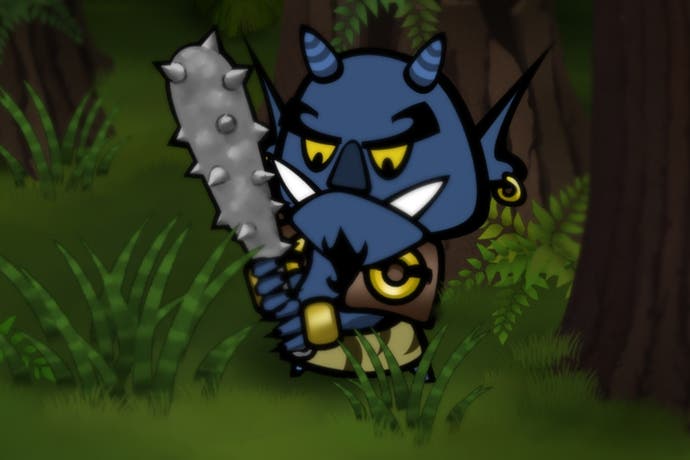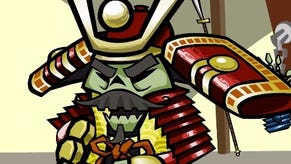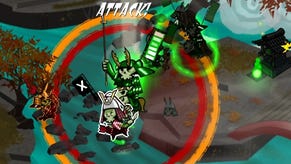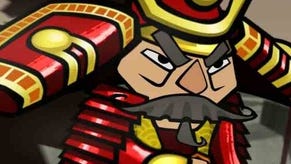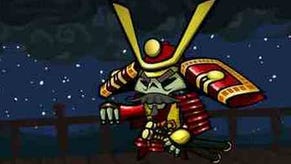Skulls of the Shogun review
Intelligent systems.
Skulls of the Shogun originally released this January on Xbox 360 and Windows 8 devices, and to celebrate its arrival on Steam we're republishing our original review.
You expect turn-based games to be tactical, but don't you hope they'll be tactile as well? I find it hard to play Advance Wars without pleasant day-dreamy thoughts of putting those chunky little tanks, soldiers and snub-nosed bombers away in a battered wooden chest afterwards, where their bright paint and die-cast bodies would be safe from the iniquities lavished by pets. Equally, I absolutely know that, as an eight-year-old, I would have stored my XCOM troops in a cereal box base with a door and a handful of windows punched in the front.
I can't imagine a safe place to keep Oni from Skulls of the Shogun, however. Like the rest of cast, I suspect he'd be made from sheets of thick, deckle-edged card and stamped with grainy ink in a handful of simple colours. He's too combustibly violent to be contained by mere paper or wood, though, too wilful to lurk inside Tupperware without gnawing a hole through the plastic. Whether you're playing Skulls on the telly or the touchscreen of a Windows Phone, you'll be glad there's an impenetrable barrier between the two of you. Oni's fun, but he's frequently a terrifying kind of fun.
Oni's a special unit that tends to dominate any maps he's placed on. You'll need to level up a salamander monk in order to access him, and then you can cast him onto an enemy player and wait for him to spawn. Once he appears on the scene, he takes the form of a big fat devil with furious eyes and neat little horns. He gets his own turn in between turns for your units and rivals', and he'll attack your foes for pretty significant damage. So far so good, but that's only the half of it. Oni's just as happy to lay into the team that created him: once he's out on the field he's a mad creature of AI-managed id, raging and lashing out and generally causing havoc.

Havoc is never far away here. 17-Bit's tactical battler is clearly inspired by classics like Advance Wars and Fire Emblem, but it's made careful tweaks throughout its structure to keep games fast, focused and enviably violent. It feels like its own beast. Unit counts are low (you get three basic types of troops, three additional monks and a general); strengths and weaknesses are well-signposted and easy to remember (cavalry has a decent reach to make up for its weak offence, while fox monks can heal but will only deal damage when countering); resources (in this case it's rice - the paddies must be haunted by a unit before the harvests can be spent on new recruits) are finite, meaning that games can't get caught in near-infinite loops where two balanced sides keep spawning until the battle's devolved into mindlessness.
Most importantly, though, each side can only take five moves per turn, regardless of how many units they have in play. All of this forces you to prioritise, to focus on exactly what you hope to achieve in each round. It encourages you to explore different rhythms of aggression as you map new ideas onto the terrain. When I try and picture the decision tree for Skulls, I see a perfect little bonsai as opposed to the sprawling thickets of other more rangy - and confusing - tactical games. I see vivid creativity born of elegance, confidence, restraint.
Alongside the Phantom Brave-style movement rings that replace tiles - making the available actions of any unit easy to comprehend while adding extra nuance to their placement - this solid foundation allows for a compact battler in which nuttier ideas like Oni can really shine. When the basic environment's so simple to read, why not chuck in a risk/reward unit who can't be controlled by either side? Why not allow for knockbacks that see even fully-powered characters dying in one hit? Why not create a levelling system that unlocks an extra action per turn for each unit if they eat three skulls left by defeated enemies?
These ideas work so well because they're deeply enmeshed with the game's clockwork. Knockbacks can be countered by spirit walling, for example, where you place your own units together so that they remain locked on the spot. Levelling's balanced out by the fact that you'll often have to choose whether to eat a skull or perform another action - attacking or capturing resources, say. You generally can't do everything in a single turn, and on tight maps, the wrong decision will be costly.
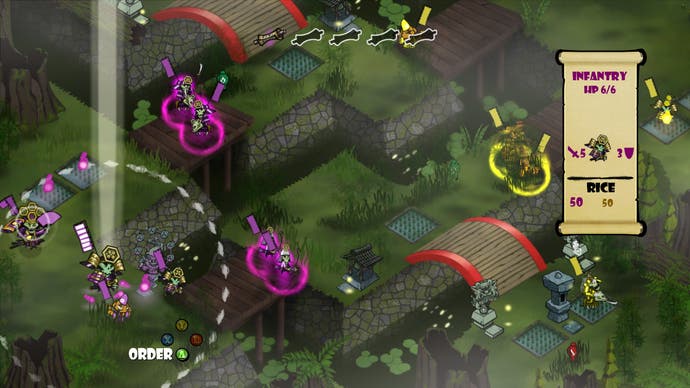
And so systems beget more systems. Skulls, which ostensibly mark the sites of former battles, start to dictate where future battles are likely to be fought, as players move in on these powerful resources. Paddies and shrines (some allow you to spawn basic units if you have enough rice, others summon monks or deal regular damage to enemies) become pinch-points too, layered on top of the already tricksy geometries of maps that include bamboo to hide within, ice to slide around on and thorns to get knocked into.
Each turn in Skulls is ripe with possibilities for strategies. Since you can still shift positioning after an attack, providing you have enough movement left in the tank and have survived any counters, you can often race in, smack someone around and then race out again, hopefully even ending up on a haunted paddy that will provide a little healing. Each turn in skulls is also ripe with possibilities for disaster. If matching the right units sees you avoiding counter-attacks entirely, getting it wrong can leave you underpowered and vulnerable. This is the sort of tactical game where you genuinely can play a single mission on the same small map again and again, getting different outcomes each time depending on your approach. In other words, it's the best sort of tactical game.
Special units, meanwhile, see the campaign varying its pace over what amounts to five or six hours of single-player battling. Monks, once summoned from far-flung shrines, come in three basic flavours, allowing you to heal, shoot fire or gust friends and enemies around for fun and profit. Feed them skulls and they'll gain additional powers, including the unleashing of our good friend Oni, but also the ability to revive downed units, steal resources and control lighting. Generals, finally, are super-powerful hero units who must nonetheless be protected at all costs, since their death means the end of the match. They start off with an extra attack per turn, however, and they often begin a match snoozing, earning an additional chunk of health for every move in which you choose not to wake them.
Monks and generals mean that success with even the simplest maps can hinge on a couple of basic, fundamental decisions, while the best levels employ a handful of extra tricks, such as one mission that sends you scampering up a staircase past various caves that intermittently spawn Onis, or another that takes place on a mountainside beset with regular avalanches. These are moments you'll really remember. Even when there's no show-stopping strategic gimmick to enjoy, there's the thick-lined '60s anime art, which manages to feel delicate one minute and elastically muscular the next, and a script that turns each enemy you face into a comic foil as a betrayed general rights wrongs in the land of the dead. Skulls is the product of a small team who clearly care very deeply about getting the details right: it's both homemade and precision-crafted. It's a mini masterpiece.
It's not all that mini, actually, when you throw in the multiplayer. Alongside deathmatch and team deathmatch - available locally (or online if you're on 360) - you've got an excellent asynchronous battling option that works across the Windows 8, Surface, and Windows Phone versions as well as the 360. Human opponents are a great fit for this arcadey spin on strategy, and they'll also remind you of how good Skulls' AI is: it feels like you're facing meatspace opponents even in the solo campaign. The whole thing also scales brilliantly for four-player combat, while the addition of bots, pass-the-pad and the ability to forge and break alliances is indicative of Skulls' thoughtful finish.
If the appeal of 17-Bit's debut initially comes down to the fact that it's been so openly influenced by the likes of Advance Wars and Phantom Brave, a true mark of this adventure's ultimate achievement is that you won't really think much about other titles when you play it. Fast, compact and yet consistently thoughtful, there's nothing else quite like Skulls of the Shogun - and, for me, it earns its place amongst the genre's greats. It takes a game with a strong identity to learn from the best and still retain such a bold character; it takes a game with a truly tidy mind to unleash such fearsome torrents of chaos.
